Lahaina
At the western end of Maui, safely away from any Heleakala eruptions, was the ancient royal capital of Maui called Lele (‘relentless sun’ in Hawaiian). In the 1790s King Kamehameha I from the Big Island took control of Maui and Lele lst its status of royal capital. From 1820 to 1845 King Kamehameha III made Lahaina, as the town had been renamed, his royal capital in preference to Honolulu. In the 1820s western whalers arrived and Lahaina grew into a major whaling port. The whaling ships often stayed for several weeks and the town became infamous for heavy drinking and prostitution. When the whaling industry went into decline towards the end of the 19th century, Lahaina was left with only the sugar trade until that too declined. The decline of the town spared it from development, leaving it with many buildings from the whaling and sugar trade eras. Today tourists flock to Lahaina for its historic buildings, art galleries and restaurants.
Old Lahaina Court House
A town filled with unruly seafarers needed both law enforcement and tax collection. Lahaina Court House was built between 1858 and 1859 to satisfy this need. It was built using materials from the ruins of the western palace built by Kamehameha III. Opened in 1860, the building housed a courtroom, post office, tax collector’s office, and offices for the Governor of Maui, Sheriff and District Attorney. It was extensively rebuilt in 1925 and remained in use until the 1970s. Old Lahaina Court House now open houses the Lahaina Visitor Center and the Lahaina Heritage Museum.
Baldwin Home Museum
Missionaries arrived in Lahaina in the 1820s and at the request of a local chief they opened a mission school in 1824. There was frequent conflict beween the missionaries and the unruly whalers. The Baldwin Home was built between 1834-35 by Reverend Ephraim Spaulding as a single storey mission compound. In 1836 ill health forced Reverend Spaulding to return to the USA, so Reverend Dwight Baldwin and his wife moved in to the house. He was a medical missionary who had arrived on Maui in 1835. The Baldwins had eight children (two died in childhood) so an upper floor was added in 1846. They lived in the house until retirement in 1868. Baldwin Home Museum is the oldest house still standing on Maui. It has been restored and is open to the public. Click Tab 2 to see a picture of the Dining Room.
Front Street at night
Front Street is where you will find most of the shops, bars, restaurants and galleries It is busy morning, evening and night. On street parking in the area is an absolute nightmare. This picture was taken from the balcony of the historic Pioneer Inn which opened in 1901 and still operates as an hotel. The entrance to the Inn is in Wharf Street but the rear of the hotel overlooks Front Street. Click Tab 2 to see a picture of the Pioneer Inn.
Gatehouse, Hale Pa'ahao Prison
The town needed somewhere to put the lawless and originally this was a jail in a fort on the waterfront. By the peak of the whaling boom in the 1850s the jail had become too small for the level of lawlessness so Hale Pa‘ahao (stuck-in-irons house in Hawaiian) was built to replace it. The old fort was demolished and the coral blocks from it were used to build the walls surrounding the yard at the new prison. Most seafaring prisoners stayed only a short time as their Captain would soon arrive and pay the necessary bounty. The gatehouse shown in this picture is where the prison warden lived. Hale Pa'ahao Prison is open daily and admission is free. Click Tab 2 to see a picture of one of the prison cells.
DLU160718
Click on Minimap to navigate
Wo Hing Museum, Front Street
In the 1850s many Chinese came to work in the sugar plantations and sugar mills. The Chinese workers set up Tong Societies to maintain social and political ties with their homeland and to provide support to the expatriates. In the early 1900s Chinese workers in Lahaina formed the Wo Hing Society, at the time a branch of the Chee Kung Tong. They built a meeting hall in 1912 which had a temple upstairs and a social hall downstairs. The building was restored in 1983 and opened to the public as the Wo Hing Museum.
Lahaina Station, Sugar Cane Train
A relic of Lahaina’s days as a sugar town is a restored plantation railway. The Sugar Cane Train has operated since 1970 carrying tourists between Lahaina and Puukolii. When we visited it was closed, so we were unable to take a ride. Click Tab 2 to see one of the old steam locomotives on display at the station.


To move forwards or backwards through the Maui Trail click the arrows above, or select your next destination on the Minimap.

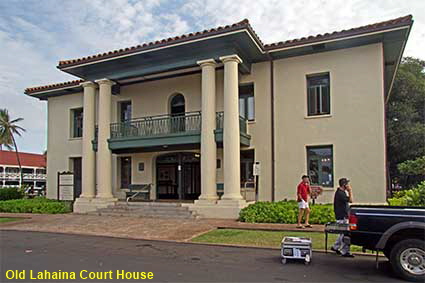
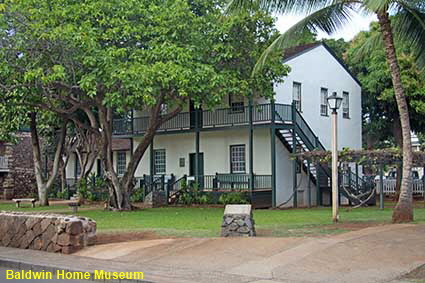
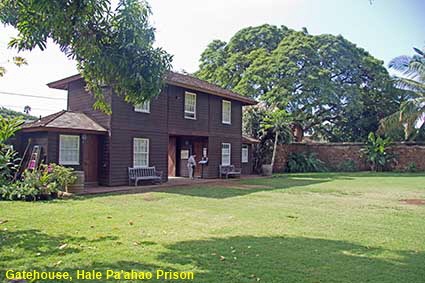
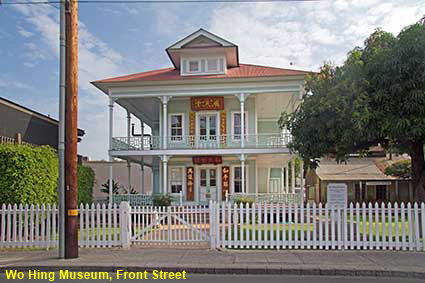
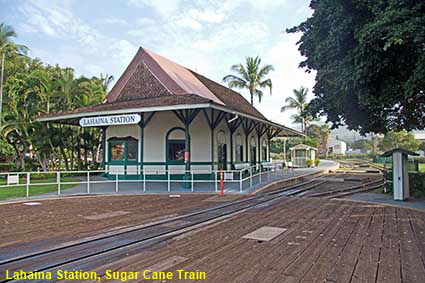
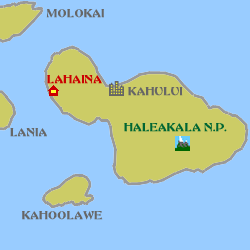

© Mike Elsden 1981 - 2025
The contents of this page may not be reproduced in full or in part without permission